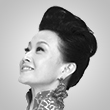 Song Zuying & China Philharmonic Orchestra
Song Zuying & China Philharmonic Orchestra
"Epics Of Love" - An Anthology of Ancient Chinese Poetry
Renowned Chinese ethnic vocalist Song Zuying, accompanied by conductor Yu Long and China Philharmonic Orchestra, performs an anthology of ancient Chinese poems that spans over 2,500 years of time.
The Stockfisch-SACD "Epics Of Love" feat. Song Zuying and the China Philharmonic Orchestra was nominated for the 57th Annual GRAMMY Awards (2015) in the category "Best Surround Sound Album". Follow the link to www.grammy.com
Stockfisch-ShopTRACKLISTING / SAMPLES
- Crying Ospreys
- Song of the Yue Boatman
- Song of the Western Islet
- For the Moment, Drinking Wine
- A Journeyer’s Song
- A Twig of Mume Blossoms
- A Riverside Town
- Charm of a Maiden Singer
- On the Trail of Sweet Incense
- Slow, Slow Tune
- Bells Ringing in the Rain
- Phoenix Hairpin
- To the Tune “Groping for Fish”
- The Peony Pavilion
 "Epics Of Love"
"Epics Of Love"
The essence of love both graceful and epic, transforming over generations through the works of Chinese "Literati", is wonderfully embodied into the sensational vocal performance of the unique singer.With an ensemble of prominent musical talents in the country, the album illustrates the marriage of East and West by modern classical orchestrations and choirs crossing-over with exotic Chinese solo instruments and recitals. Tasked with such an ambitious project, the Stockfisch crew travelled to Beijing with their own equipment in 2011, recorded in the spectacular concert hall of China National Radio.

"Epics Of Love" is mastered in multi-channel hybrid SACD, with a 5.1 surround mix that captures the breathtaking acoustic ambience.
A 60-page book was the format of choice for the rich collection of original Chinese poems, English translations, literature synopses, studio & sessions photos, and many more.
Super-Audio-CD Hybrid: SACD Stereo + 5.1 Surround + CD-Layer
SFR 357.9014.2 • total time 68:57
shop
 musicians
musicians
performing on this album "EPICS OF LOVE" :Song Zuying - vocal / China Philharmonic Orchestra, cond. Yu Long / Wang Zhongshan - Guzheng / Zhang Qiang - Pipa / Zhao Jiazhen - Guqin / Dai Ya – Dizi / Zhang Hua - Dizi / Du Cong - Xiao / Tang Ze - Erhu / Sun Huang - Erhu / Chen Daoming - Recitalist / Pu Cunxi - Recitalists / Liao Changyong - Male Vocalist / Choir of China Opera and Dance Drama Company / Children’s Choir of China Central Radio
 The origin and development of ancient Chinese poetry
The origin and development of ancient Chinese poetry
China is a country of poems. For thousands of years, poetry was the predominant form of Chinese literature.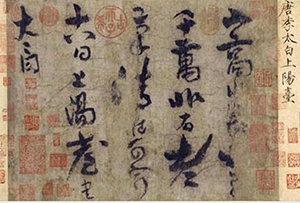
Li Bai (701-762). Calligraphy in his own handwriting.
Before the invention of pictogram characters, Chinese in ancient times just used simple instinctive sounds to express emotion. These sounds developed into tunes which were composed about experiences in everyday life, and these in turn became catchy melodies which were passed down through generations. This is what we now call a “song”. Then, after sophisticated Chinese characters emerged, people began to incorporate lyrics into the tunes. A typical song had two parts; one is the melody - to express emotion - the other is the lyric, which records events.
The Book of Songs (Shi Jing) is the oldest compilation of poetry in Chinese history (circa 1046-771 B.C.). It comprised of three sections: “stylistic”(feng), “classic”(ya) and “ritualistic”(song), all of which could be performed vocally together with instruments. The book is considered to be the very foundation of Chinese literature and art. Track 1 "Crying Ospreys" on this SACD is taken from "The Book of Songs".
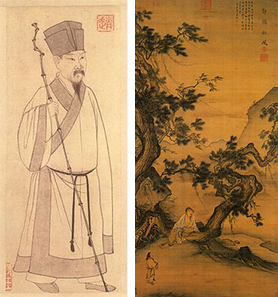
Su Shi (1037-1101) Ink and color on silk.
Ma Lin, 1246
The Songs of Chu (Chu Ci), emerged in the south towards the end of Warring States period (circa 221 B.C.), this new form of popular poetry featured irregular stanzas with six or seven characters. Later during the Han dynasty (circa 112 B.C.), the royal government “Music Bureau” (Yue Fu) was established for collecting and cataloguing folk songs. These songs were often written about daily life using simple language, and as a result became popular even among ordinary people.
Many consider the Tang dynasty (618-907 A.D.) to be the prime period of Chinese poetry. Various forms of poetic styles appeared, each had it’s “maestro”. Li Bai was known for his “romanticism” - with much colourful and emotional expression. Du Fu inherited the traditional essence of “realism” combined with deep melancholy. Together they are hailed as truly inspirational “Literati” who influenced centuries of Chinese poetry.The lyrics of Track 4 on this SACD are written by Li Bai.
In the Song dynasty (960-1279 A.D.), the dominant poetic form, “Ci”, had two mainstream styles; the “graceful & subtle” (wan yue), and the “epic & heroic” (hao feng). The former was characterised by elegance and expression of inner feelings, the latter emphasised magnificence and social themes. Li Qingzhao (1084-1151 A.D.) was the most famous female Chinese writer and poet of the Song dynasty.
On this SACD "Epics Of Love" Song Zuying sings among others Li Qingzhao´s poem "A Twig Of Mume Blossoms" to the tune of "Yi Jian Mei" (Track 6). Look at the poem written in traditional Chinese in the typical 7/4-4 structure beside the poetess´ portrait.
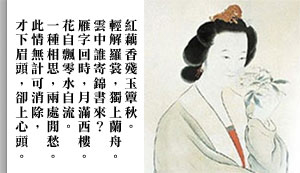
Li Qingzhao
The jade-like mat feels autumn’s cold, I change a coat
And ’mid the fading fragrance / Of lotus pink alone I boat.
Will wild returning geese bring letters through the cloud?
When they come, with moonbeams / My west chamber’s o’erflowed.
As water flows and flowers fall without leaving traces,
One and the same longing / O’erflows two lonely places.
I cannot get rid of this sorrow: kept apart
From my eyebrows, / It gnaws my heart.
Translation: Xu Yuanchong
 Recording Sessions in China National Radio, Beijing
Recording Sessions in China National Radio, Beijing
Engineer Günter Pauler received an invitation from the Chinese Opera and Dance Conservatory to be involved in an ambitious project with China’s famous singer, Song Zuying - accompanied by the China Philharmonic Orchestra and many soloists - to record an anthology of ancient Chinese love songs. Pauler had worked for Chinese record companies previously and in a preliminary trip to Beijing decided that the large studio of the Chinese National Radio should be the venue. After an assessment on the in-house technology and infrastructure Pauler decided to bring his own equipment, ranging from microphones to voltage stabilisation units.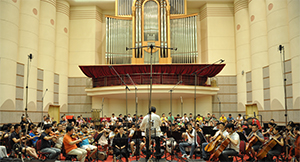
China Philharmonic Orchestra, concert hall of
China National Radio, Peking, cond. Yu Long
A team of three - musicologist Hans-Jörg Maucksch, technical assistant Inés Breuer and Pauler himself - flew out for the sessions in September 2011 with the equipment, arriving in good time. For the main microphones they used a Decca Tree of three DPA 4041s and two Neumann TLM 50s as out-riggers.
Additional microphones for the string sections were Sennheiser MKH 800 Twins, chosen for the freedom to choose directivity later in the mix. With 120 orchestral musicians, seven soloists on traditional Chinese instruments, two choirs, a male vocalist, recitalists and Song Zuying they needed a wide selection of mics and they had models from Sennheiser, DPA, Sonodore, Schoeps, AEA, Josephson, and Microtech-Gefell.
The amount of support microphones would appear to be a bit big at first glance but it was impossible to predict beforehand, what importance should be given to the individual instruments / groups in the mix that the musical director Meng Yong would require.
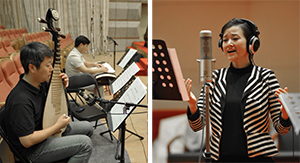
Pipa (lute) & Gu Zheng (zither)
Song Zuying
The microphone for Song Zuying’s vocal performances was a Josephson C700A with two capsules (fig-8 and omni). It has the advantage of being able to vary the ambient and direct sound independently later in the mix. For mic preamps and A-D converters they used Stagetec Nexus and 48 channels were transported via MADI to a SADiE LRX2 recorder. The LRX2 is a highly professional and practically orientated recording system. Motor fader controllers gives you a genuine studio feeling. In between recording pauses the system can be used for editing purposes.
Certain quieter traditional instruments had to be moved from their placement in the orchestra and repositioned behind the conductor Yu Long for reasons of clarity. There was a problem with the separation between the choir and the orchestra and to this end they employed the Microtech-Gefell KEM 970, which has eight stacked capsules and acts like a line array. An opening angle of 30º on a vertical half-circle it uses LEDs for alignment and permitted a very precise positioning on the choir.
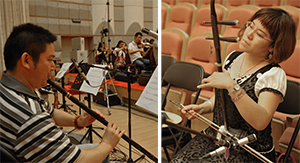
Xiao (flute) Er Hu (bowed instrument)
The Quad Cable from Schoeps utilizes two conductors, halves the capacity (shield / conductor) and makes nearly so many microphones sound better. For this reason, we have been using it for a long time, and as well as this, it is extremely durable and mechanically very strong. It is now newly available with Neutrik EMC connectors. These connectors/couplers have internal passive components, which are intended to increase the stability of the HF by almost 90%. The sound perception is quiet, producing a stable location imagery and has a clean harmonic structure.
The PS-Audio conditioners convert the primary AC power to DC, then again with a new 50Hz frequency to 220V thereby reducing harmonic distortion and DC component and eliminating high frequency. In Pauler’s famous Stockfisch studios they use separate PS-Audio conditioners for digital and analogue power.

